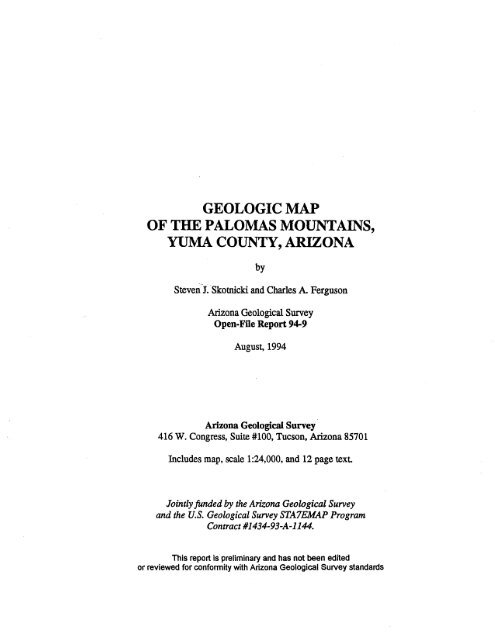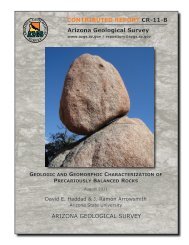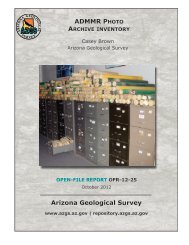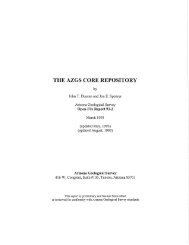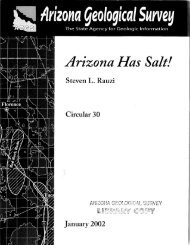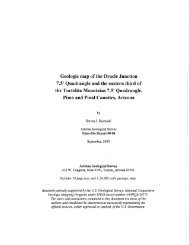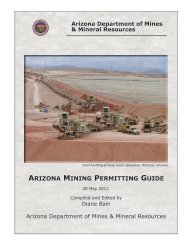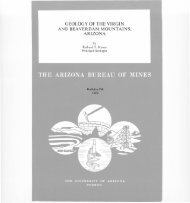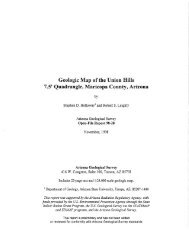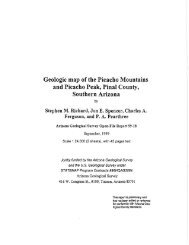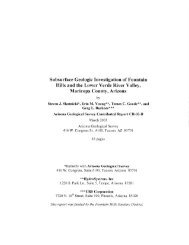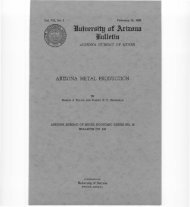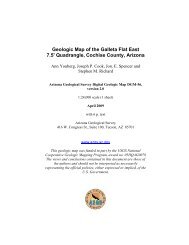Geologic Map of the Palomas Mountains, Yuma County, Arizona
Geologic Map of the Palomas Mountains, Yuma County, Arizona
Geologic Map of the Palomas Mountains, Yuma County, Arizona
Create successful ePaper yourself
Turn your PDF publications into a flip-book with our unique Google optimized e-Paper software.
INTRODUCTION<br />
The <strong>Palomas</strong> <strong>Mountains</strong> are located approximately 70 miles nor<strong>the</strong>ast <strong>of</strong> <strong>Yuma</strong>, <strong>Arizona</strong>, and<br />
about 15 miles north <strong>of</strong> <strong>the</strong> town <strong>of</strong> Dateland in eastern <strong>Yuma</strong> <strong>County</strong> (Figure 1). Across a narrow<br />
valley to <strong>the</strong> north are <strong>the</strong> Tank <strong>Mountains</strong>, which form a continuous belt <strong>of</strong> bedrock westward into <strong>the</strong><br />
K<strong>of</strong>a <strong>Mountains</strong>. To <strong>the</strong> west lies Neversweat Ridge, which is <strong>the</strong> eastern-most known exposure <strong>of</strong><br />
Orocopia Schist. To <strong>the</strong> east and nor<strong>the</strong>ast is <strong>the</strong> <strong>Palomas</strong> Plain, and to <strong>the</strong> south is <strong>the</strong> Gila River.<br />
Accessibility to <strong>the</strong> range is generally good. Most <strong>of</strong> <strong>the</strong> dirt roads are in good condition and can<br />
be partially traversed by a two-wheel drive vehicle. However, because <strong>the</strong>y cross many sandy washes <strong>the</strong><br />
roads are only passable with a four-wheel drive vehicle. The western half <strong>of</strong> <strong>the</strong> range lies within <strong>the</strong><br />
<strong>Yuma</strong> Proving Ground and permission must be obtained before entering. Besides <strong>the</strong> current munitions<br />
testing on <strong>the</strong> Proving Ground most <strong>of</strong> <strong>the</strong> sou<strong>the</strong>rn portion <strong>of</strong> <strong>the</strong> mountains was <strong>the</strong> site <strong>of</strong> military<br />
training during World War II. Rusted fragments <strong>of</strong> shrapnel, small craters, and tank and vehicle tracks<br />
are numerous. Two miles west <strong>of</strong> <strong>the</strong> curve in <strong>the</strong> paved road heading north from Dateland is a<br />
monument commemorating <strong>the</strong> training <strong>of</strong> <strong>the</strong> 81st Infantry Division.<br />
Field work was carried out between December, 1993, and April, 1994, and was contemporaneous<br />
with mapping in <strong>the</strong> Tank <strong>Mountains</strong>. The study area encompasses parts <strong>of</strong> <strong>the</strong> following 1:24,000 U.S.<br />
<strong>Geologic</strong>al Survey topographic maps: <strong>Palomas</strong> <strong>Mountains</strong> SW, <strong>Palomas</strong> <strong>Mountains</strong> SE, K<strong>of</strong>a, and Horn.<br />
Plate 1 uses <strong>the</strong>se maps as a base. This project was jointly funded by <strong>the</strong> <strong>Arizona</strong> <strong>Geologic</strong>al Survey and<br />
<strong>the</strong> U.S. <strong>Geologic</strong>al Survey STATEMAP program, contract #1434-93-A-1l44.<br />
PREVIOUS INVESTIGATIONS<br />
Previous geologic studies <strong>of</strong> <strong>the</strong> area include reconnaissance surveys incorporated into <strong>the</strong> State<br />
geologic map by Wilson and o<strong>the</strong>rs (1969) and <strong>the</strong> Ajo lOx 2 0 Quadrangle by Gray and o<strong>the</strong>rs (1988).<br />
A study <strong>of</strong> <strong>the</strong> geology, geochronology and mineral resources by Bagby and o<strong>the</strong>rs (1987) covered <strong>the</strong><br />
adjacent K<strong>of</strong>a National Wildlife Refuge and included three K-Ar dates <strong>of</strong> rocks in <strong>the</strong> <strong>Palomas</strong> <strong>Mountains</strong>.<br />
Wilson (1933) also briefly described <strong>the</strong> geology and mineralization <strong>of</strong> <strong>the</strong> area within and surrounding<br />
<strong>Yuma</strong> <strong>County</strong>.<br />
GEOLOGIC SETTING<br />
The <strong>Palomas</strong> <strong>Mountains</strong> are within <strong>the</strong> Basin and Range physiographic province. Bedrock<br />
geology includes a Miocene granitic pluton dated at 23.2±0.5 Ma (biotite K-Ar date from Bagby et aI.,<br />
1987) overlain by felsic and mafic Miocene volcanic rocks (plate 1; Figures 2 and 3). A myriad <strong>of</strong><br />
northwest-trending dikes intrude <strong>the</strong> granite, as does a northwest-striking, southwest-dipping sheet-like<br />
body <strong>of</strong> pegmatitic granite. Exposures <strong>of</strong> unfoliated hornblende-biotite granite in <strong>the</strong> sou<strong>the</strong>rn Tank<br />
<strong>Mountains</strong> may be related to <strong>the</strong> granite in <strong>the</strong> <strong>Palomas</strong> <strong>Mountains</strong>. Locally exposed banded gneiss and<br />
porphyritic granite/quartz monzonite are possibly related to similar rocks in <strong>the</strong> Tank <strong>Mountains</strong>. They<br />
occur below <strong>the</strong> volcanic section north <strong>of</strong> <strong>the</strong> central wash and as small lenses within <strong>the</strong> granite in <strong>the</strong><br />
west.<br />
The range is surrounded by gently sloping piedmonts <strong>of</strong> various ages. To <strong>the</strong> sou<strong>the</strong>ast basin-fill<br />
deposits form raised terraces which are extensively dissected. These deposits are horizontally stratified<br />
and have developed a dark, coarse lag gravel on <strong>the</strong> upper surfaces. Locally, <strong>the</strong> younger fans are very<br />
thin, revealing granite pediments below. The northwest end <strong>of</strong> <strong>the</strong> range is underlain by gently nor<strong>the</strong>astdipping<br />
older Tertiary basin-fill deposits. These deposits are conglomerates and debris flows composed<br />
almost entirely <strong>of</strong> <strong>the</strong> youngest andesite unit, and dip 3 0 -10 0<br />
nor<strong>the</strong>ast. The sou<strong>the</strong>rn edge <strong>of</strong> <strong>the</strong> deposit<br />
is defined by an abrupt slope several hundred feet high.<br />
1
On <strong>the</strong> north and nor<strong>the</strong>ast sides <strong>of</strong> <strong>the</strong> mountains, many relatively flat caliche-capped terraces<br />
overlie basalt hills (not shown on map). It is not clear if <strong>the</strong> terraces represent separate older erosion<br />
surfaces or one surface which has been faulted prior to deposition <strong>of</strong> <strong>the</strong> youngest andesite lavas. In sec.<br />
1, T. 5 S., R. 14 W., andesite lavas overlap a steep, northwest-facing slope in <strong>the</strong> underlying basalt.<br />
The slope may represent a degraded fault scarp or may simply be an erosional feature.<br />
DIKES<br />
Most <strong>of</strong> <strong>the</strong> dikes are well-exposed in <strong>the</strong> Tertiary granite and <strong>the</strong> older metamorphic rocks.<br />
Although two types are shown on <strong>the</strong> map <strong>the</strong>re are variations <strong>of</strong> each. The felsic dikes include feldspar<br />
porphyry and quartz-feldspar porphyry dikes. Each includes variable amounts <strong>of</strong> ei<strong>the</strong>r biotite and<br />
hornblende or both. The porphyry dikes are coarser-grained toward <strong>the</strong> cores where <strong>the</strong>y are commonly<br />
granitic. The mafic dikes include dark aphanitic basalt and grey-green medium- to fine-grained<br />
plagioclase-hornblende dikes. In general, <strong>the</strong> mafic dikes appear to be older than <strong>the</strong> felsic dikes, but<br />
cross-cutting relationships are rare and <strong>of</strong>ten equivocal. In many areas swarms <strong>of</strong> thin mafic dikes appear<br />
to be intruded by wider felsic dikes. In some areas, particularly to <strong>the</strong> east, felsic dikes appear to be<br />
emplaced along <strong>the</strong> margins <strong>of</strong> earlier mafic dikes. A K-Ar biotite date <strong>of</strong> 22.6±OA Ma was obtained<br />
from one felsic dike (Bagby et aI., 1987).<br />
The strikes <strong>of</strong> <strong>the</strong> dikes are predominantly northwest-sou<strong>the</strong>ast but strike closer to north-south<br />
progressively to <strong>the</strong> west. This trend appears to continue to <strong>the</strong> northwest outside <strong>the</strong> study area at<br />
Neversweat Ridge (Grubensky, Haxel and Demsey, in press) where north-northwest-trending mafic dikes<br />
intrude Orocopia schist. Locally, in <strong>the</strong> west-central part <strong>of</strong> <strong>the</strong> granitic body, felsic dikes strike nearly<br />
north-south and dip very gently to <strong>the</strong> west. Their attitudes suggest that <strong>the</strong>y may be <strong>of</strong> a different age<br />
than nor<strong>the</strong>ast- and east-dipping dikes to <strong>the</strong> east. The number and thickness <strong>of</strong> dikes decreases to <strong>the</strong><br />
west. The dips <strong>of</strong> <strong>the</strong> dikes vary from about 75 0 -80 0 NE in <strong>the</strong> nor<strong>the</strong>ast to 20 0 -40 0 NE in <strong>the</strong> southwest.<br />
STRUCTURE<br />
Most <strong>of</strong> <strong>the</strong> exposed faults are northwest-trending high-angle normal faults. Where discernable,<br />
<strong>of</strong>fsets are less than 100 meters, and typically are expressed as small horsts and grabens. No detachment<br />
faults were recognized, though <strong>the</strong>re is a large, high-angle normal fault juxtaposing <strong>the</strong> Tertiary volcanic<br />
sequence and Mesozoic or Proterozoic rocks on <strong>the</strong> nor<strong>the</strong>ast with Miocene granite on <strong>the</strong> southwest.<br />
The fault projects through <strong>the</strong> narrow alluvial-filled valley running through <strong>the</strong> center <strong>of</strong> <strong>the</strong> mountain<br />
range. It is not clear how much <strong>of</strong>fset has occurred on this fault. Many <strong>of</strong> <strong>the</strong> faults have been filled<br />
with dark carbonate (possibly siderite or manganiferous calcite), locally intergrown with quartz.<br />
Slickensides in <strong>the</strong> carbonate indicate that faulting continued during or after deposition <strong>of</strong> <strong>the</strong> calcite. The<br />
carbonate is locally more resistant than <strong>the</strong> granite and forms small resistant ridges. Because <strong>the</strong> older<br />
tuffs and basalts dip more steeply to <strong>the</strong> north-nor<strong>the</strong>ast than do <strong>the</strong> younger units, most <strong>of</strong> <strong>the</strong> faulting<br />
in <strong>the</strong> area appears to have occurred prior to deposition <strong>of</strong> <strong>the</strong> younger cliff-forming basalt. However,<br />
<strong>the</strong> younger andesite lavas, which overlie <strong>the</strong> younger basalts, cover a steep slope in <strong>the</strong> underlying<br />
basalt. Local Accumulations <strong>of</strong> tuff and breccia associated with <strong>the</strong> andesite show that <strong>the</strong> slope existed<br />
before deposition <strong>of</strong> <strong>the</strong> andesite. It is not clear if <strong>the</strong> slope was formed by erosion or by faulting <strong>of</strong> <strong>the</strong><br />
upper basalt.<br />
The Tertiary supracrustal rocks all appear to dip to <strong>the</strong> north-nor<strong>the</strong>ast. Most <strong>of</strong> <strong>the</strong> volcanic<br />
rocks in <strong>the</strong> <strong>Palomas</strong> <strong>Mountains</strong> crop out north <strong>of</strong> <strong>the</strong> Miocene granitic pluton and are separated from it<br />
by a major north-side-down fault. Volcanic rocks also exist south <strong>of</strong> <strong>the</strong> fault but only near <strong>the</strong> western<br />
end <strong>of</strong> <strong>the</strong> range. The Tertiary volcanic rocks, both north and south <strong>of</strong> <strong>the</strong> fault, dip about 5 0<br />
_20 0<br />
to <strong>the</strong><br />
nor<strong>the</strong>ast. However, south <strong>of</strong> <strong>the</strong> major fault to <strong>the</strong> east, where supracrustal rocks are absent, it is<br />
2
difficult to determine <strong>the</strong> direction and magnitude <strong>of</strong> tilting. The relationship between <strong>the</strong> dikes and<br />
pegmatite sill within <strong>the</strong> granitic body may be <strong>of</strong> use in approaching <strong>the</strong> problem. The dikes and<br />
pegmatite are everywhere oriented at high angles to each o<strong>the</strong>r, typically greater than 80 degrees, and<br />
<strong>the</strong> pegmatite is locally oriented parallel to a crude magmatic layering within <strong>the</strong> granite. The implication<br />
<strong>of</strong> <strong>the</strong>se observations is that <strong>the</strong> pegmatite was originally emplaced as a subhorizontal sill-like body and<br />
later intruded by subvertical dikes, and <strong>the</strong> current orientations <strong>of</strong> <strong>the</strong>se bodies may indicate <strong>the</strong> direction<br />
and magnitude <strong>of</strong> tilt that <strong>the</strong> rocks have undergone. The dip <strong>of</strong> <strong>the</strong> dikes decreases to <strong>the</strong> southwest<br />
whereas <strong>the</strong> dip <strong>of</strong> <strong>the</strong> pegmatite increases, suggesting that, to <strong>the</strong> southwest, <strong>the</strong> granite may be broken<br />
into southwest-dipping blocks bounded by north-side-down normal faults. This sense <strong>of</strong> tilting (to <strong>the</strong><br />
southwest) is opposite to that <strong>of</strong> <strong>the</strong> volcanic rocks to <strong>the</strong> nor<strong>the</strong>ast.<br />
The timing <strong>of</strong> faulting is not well-constrained. Talus and alluvium obscure much <strong>of</strong> <strong>the</strong> bedrock<br />
and make it impossible to visually follow faults for long distances. Tertiary supracrustal rocks west <strong>of</strong><br />
<strong>the</strong> major fault are much thinner than that to <strong>the</strong> nor<strong>the</strong>ast, and basalt (map units Thu + Thm) and <strong>the</strong><br />
Tuff <strong>of</strong> Ten Ewe Mountain (Tte) rest directly on Miocene granite. The two basalt map units are<br />
attenuated with respect to <strong>the</strong> same units on <strong>the</strong> nor<strong>the</strong>ast side <strong>of</strong> <strong>the</strong> fault. The absence <strong>of</strong> older units<br />
suggests that <strong>the</strong> major fault is a growth fault. The older volcanic units may have been removed by<br />
erosion prior to deposition <strong>of</strong> <strong>the</strong> Tuff <strong>of</strong> Ten Ewe Mountain and <strong>the</strong> younger basalt.<br />
<strong>Map</strong> unit Ttv is <strong>the</strong> youngest unit visibly cut by <strong>the</strong> main fault. However, a smaller fault on <strong>the</strong><br />
north side <strong>of</strong> <strong>the</strong> main fault cuts <strong>the</strong> Tuff <strong>of</strong> Ten Ewe Mountain (map unit Tte) and possibly <strong>the</strong> upper<br />
basalt (map unit Thu). Because <strong>the</strong> smaller fault is cut by <strong>the</strong> main fault, faulting along <strong>the</strong> main fault<br />
ended after deposition <strong>of</strong> <strong>the</strong> Tuff <strong>of</strong> Ten Ewe Mountain and possibly after earliest eruption <strong>of</strong> <strong>the</strong><br />
overlying basalt. Faulting ceased before <strong>the</strong> andesite (map unit Ta) was deposited.<br />
The shallow dip <strong>of</strong> <strong>the</strong> rocks and <strong>the</strong> relatively minor <strong>of</strong>fsets <strong>of</strong> <strong>the</strong> faults indicates that <strong>the</strong><br />
<strong>Palomas</strong> <strong>Mountains</strong> have undergone relatively little. extension compared to areas far<strong>the</strong>r south, such as<br />
<strong>the</strong> Mohawk <strong>Mountains</strong> (Mueller et aI., 1982), and to <strong>the</strong> north and east as in <strong>the</strong> Little Horn and Gila<br />
Bend <strong>Mountains</strong> (Grubensky and Demsey, 1991, and Gilbert et aI., 1992).<br />
MINERALIZATION<br />
Almost all <strong>of</strong> <strong>the</strong> mineralization occurs along <strong>the</strong> nor<strong>the</strong>rn margin <strong>of</strong> <strong>the</strong> Tertiary granite and<br />
foliated granitic rocks. Many small prospects and adits have been dug at <strong>the</strong> contacts between <strong>the</strong> granitic<br />
rocks and mafic dikes where mineralization includes chrysocolla, malachite, hematite, quartz, and<br />
triangular facets <strong>of</strong> probably pseudomorphs <strong>of</strong> limonite after pyrite. Individual pseudomorphs are<br />
commonly surrounded by a rim <strong>of</strong> chrysocolla. At <strong>the</strong> England Mine (or Engles/Adams Mine)<br />
chrysocolla and malachite mineralization occurs at <strong>the</strong> junction <strong>of</strong> a quartz-feldspar porphyry dike and<br />
a basaltic dike. Workings include several short tunnels, two thirty-foot shafts on <strong>the</strong> Charles Engles<br />
claims and two shafts, 50 and 100 feet deep, on <strong>the</strong> Henry Adams Group (Wilson, 1933). Far<strong>the</strong>r west<br />
<strong>of</strong> <strong>the</strong> England Mine <strong>the</strong>re are only a few small pits associated with mafic and felsic dikes.<br />
Locally, in <strong>the</strong> eastern end <strong>of</strong> <strong>the</strong> range, in sec. 7, T. 5 S., R. 12 W., dikes <strong>of</strong> manganese oxides<br />
(probably psilomelane) fill fractures cross-cutting andesitic to dacitic volcanic rocks (Figure 4). The<br />
exposure is limited to one small ravine but it is well-exposed. The manganese is laminated and intimately<br />
associated with fine-grained white quartz and calcite. The dikes are nearly vertical, trend N35°W and<br />
vary in thickness from between several millimeters to almost a meter.<br />
3
REFERENCES<br />
Bagby, W.C., Haxel, G.B., Smith, D.B., Koch, R.D., Grubensky, MJ., Sherrod, D.R., and Pickthorn<br />
L.B.G., 1987, Mineral resource assessment <strong>of</strong> <strong>the</strong> K<strong>of</strong>a National Wildlife Refuge, <strong>Arizona</strong>:<br />
U.S. <strong>Geologic</strong>al Survey Open-File Report 87-609, 45 p.<br />
Eberly, L.D., and Stanley, T.B., 1978, Cenozoic stratigraphy and geologic history <strong>of</strong> southwestern<br />
<strong>Arizona</strong>: <strong>Geologic</strong>al Society <strong>of</strong> America Bulletin, v. 89, p. 921-940.<br />
Grubensky, MJ., Haxel, G.B., and Demsey, K.A., <strong>Geologic</strong> map <strong>of</strong> <strong>the</strong> sou<strong>the</strong>astern K<strong>of</strong>a <strong>Mountains</strong><br />
and western Tank <strong>Mountains</strong>, southwestern <strong>Arizona</strong>: U.S. <strong>Geologic</strong>al Survey Miscellaneous<br />
Investigations <strong>Map</strong> 1-2454, scale 1:62,500.<br />
Grub ensky , M.J., and Demsey, K.A., 1991, <strong>Geologic</strong> map <strong>of</strong> <strong>the</strong> Little Horn <strong>Mountains</strong> 15'<br />
Quadrangle, southwestern <strong>Arizona</strong>: <strong>Arizona</strong> <strong>Geologic</strong>al Survey <strong>Map</strong> 29, scale 1:50,000.<br />
Gilbert, W.G., Laux, D.P., Spencer, J.E., and Richard, S.M., 1992, <strong>Geologic</strong> map <strong>of</strong> <strong>the</strong> western Gila<br />
Bend and sou<strong>the</strong>rn Eagletail <strong>Mountains</strong>, Maricopa and <strong>Yuma</strong> Counties, <strong>Arizona</strong>: <strong>Arizona</strong><br />
<strong>Geologic</strong>al Survey Open-File Report 92-5, scale 1:24,000.<br />
Mueller, KJ., Frost, E.G., and Haxel, Gordon, 1982, Mid-Tertiary detachment faulting in <strong>the</strong> Mohawk<br />
<strong>Mountains</strong> <strong>of</strong> southwestern <strong>Arizona</strong>, in Frost, E.G., and Martin, D.L., eds., Mesozoic<br />
Cenozoic tectonic evolution <strong>of</strong> <strong>the</strong> Colorado River region, California, <strong>Arizona</strong> and Nevada:<br />
Cordillera Publishers, San Diego, p. 448-458.<br />
Reynolds, SJ., 1988, <strong>Geologic</strong> map <strong>of</strong> <strong>Arizona</strong>: <strong>Arizona</strong> <strong>Geologic</strong>al Survey <strong>Map</strong> 26, scale<br />
1: 1,000,000.<br />
Wilson, E.D., 1933, Geology and mineral deposits <strong>of</strong> sou<strong>the</strong>rn <strong>Yuma</strong> <strong>County</strong>, <strong>Arizona</strong>: <strong>Arizona</strong><br />
Bureau <strong>of</strong> Mines Bulletin 134, p. 129-130.<br />
Wilson, E.D., Moore, R.T., and Cooper, J.R., compilers, 1969, <strong>Geologic</strong> map <strong>of</strong> <strong>Arizona</strong>: Tucson,<br />
<strong>Arizona</strong> Bureau <strong>of</strong> Mines and U.S. <strong>Geologic</strong>al Survey, scale 1:500,000.<br />
4
DESCRIPTION OF MAP UNITS<br />
Qs Surficial deposits (Quaternary) -- Includes talus, colluvium, caliche-cemented, rubble-forming<br />
terraces, and unconsolidated alluvial deposits.<br />
Tsy Younger sedimentary deposits (Tertiary) -- Gently north- and nor<strong>the</strong>ast-dipping tan-colored<br />
conglomerate and sandstone. The unit is weakly to strongly consolidated and composed<br />
<strong>of</strong> intercalated layers <strong>of</strong> moderately sorted pebbly sandstone and conglomerate, and very<br />
poorly sorted sandy boulder conglomerate. Clasts are almost exclusively <strong>of</strong> map unit Ta,<br />
with rare basalt clasts. The individual clasts are angular to subrounded, and <strong>the</strong> matrix<br />
is tan-colored sand and silt. All conglomerate is clast-supported. Layers generally form<br />
lens-like bodies and may represent avalanche or debris flow deposits. Outcrops <strong>of</strong><br />
conglomerate are commonly covered with desert varnish and are darker than adjacent<br />
finer-grained layers. Where good exposures exist, <strong>the</strong> surface exfoliates into curved<br />
blocks and caves. Locally, high-angle joints or faults with unknown <strong>of</strong>fset trend NI5°W<br />
through well-exposed deposits.<br />
Ta Andesite (Tertiary) -- Interbedded blocky and massive flows <strong>of</strong> moderately crystal-rich mafic<br />
lavas with up to 20 % phenocrysts <strong>of</strong> plagioclase and 1 % phenocrysts <strong>of</strong> pyroxene. The<br />
uppermost part <strong>of</strong> this unit is massive, columnar jointed, strongly flow-banded lava (or<br />
possibly a welded tuff) with characteristic rounded, fine-grain mafic clots up to 5 cm in<br />
diameter. The clots show no preferential orientation or evidence <strong>of</strong> flattening, and <strong>the</strong>y<br />
appear to overprint a highly compacted or flow-banded texture. The andesite is very<br />
resistant and typically forms steep, grayish-tan blocky hills and tall cliffs.<br />
Tax Andesite breccia (Tertiary) -- Local accumulations <strong>of</strong> poorly sorted, angular, monolithic breccia<br />
at <strong>the</strong> base <strong>of</strong> andesite flows. It is possibly a flow breccia.<br />
Tta Tuff (Tertiary) -- Local accumulations <strong>of</strong> bedded tuff and tuffaceous sandstone at <strong>the</strong> base <strong>of</strong> <strong>the</strong><br />
andesite unit (Ta).<br />
Tbu Upper Basalt (Tertiary) -- Dark blue-grey basalt lava flows that varies from crystal-poor olivine<br />
and pyroxene basalt to moderately crystal-rich plagioclase-only basalt. This basalt forms<br />
resistant mesas and steep cliffs. Locally, flows are interbedded with thin intervening tuffs<br />
and sandstones. The basalt is generally vesicular and is locally crumbly.<br />
Tt Tuff (Tertiary) -- Local accumulations <strong>of</strong> yellow, bedded lapilli tuff at <strong>the</strong> base <strong>of</strong> <strong>the</strong> upper<br />
basalt.<br />
Tte Tuff <strong>of</strong> Ten Ewe Mountain (Tertiary) -- Peach-colored, densely welded, moderately crystalpoor<br />
ash-flow tuff, and locally entirely or partly unwelded bedded and/or massive tuffs,<br />
all 0-20 meters thick. Phenocrysts consist <strong>of</strong> very rare quartz, feldspar, and abundant<br />
biotite. The eastern-most extent <strong>of</strong> this unit is a 1 to 3 meter-thick sequence <strong>of</strong> unwelded,<br />
faintly bedded tuffs that separates basalt lavas (Tbu and Thm) in <strong>the</strong> sou<strong>the</strong>rn half <strong>of</strong> sec.<br />
15, T. 5 S., R. 13 W. To <strong>the</strong> west, <strong>the</strong> unit thickens and includes a densely welded<br />
zone and a 10 meter-thick unwelded base. The densely welded zone in this area is<br />
characterized by orange-colored pumice fragments with a distinctive pattern <strong>of</strong>axiolitic<br />
needle growth such that, in cross-section, <strong>the</strong> pumice resemble closed zippers. The unit<br />
wea<strong>the</strong>rs into light pink and peach-colored rounded hills. This tuff probably correlates<br />
with <strong>the</strong> tuff <strong>of</strong> Ten Ewe Mountain as mapped by Grubensky and o<strong>the</strong>rs (in press).<br />
Tsc Sandstone and conglomerate (Tertiary) -- Volcaniclastic sandstone and conglomerate up to 20<br />
meters thick that locally underlies <strong>the</strong> Tte unit. The sandstones may be eolian at easternmost<br />
exposures <strong>of</strong> this unit in section 13, T. 5 S., R. 13 W.<br />
Tr Rhyolite (Tertiary) -- Light grey to pink rhyolite lavas that contain small phenocrysts <strong>of</strong> biotite,<br />
feldspar, quartz, and rare hornblende 1 to 5 mm long. Flow-banded locally and<br />
5
commonly vitrophyric and brecciated. Exposed only on one hill north <strong>of</strong> Snyder's Well<br />
in section 25, T. 4 S., R. 13 W. near <strong>the</strong> nor<strong>the</strong>astern end <strong>of</strong> <strong>the</strong> range.<br />
Trd Rhyodacite lava (Tertiary) -- Grey moderately crystal-poor lava with up to 15% feldspar<br />
phenocrysts and little or no quartz, and rare mafic minerals. This unit is <strong>of</strong> limited<br />
extent, only present in <strong>the</strong> west half <strong>of</strong> section 15 and east half <strong>of</strong> section 16, T.<br />
5 S, R. 13 W.<br />
Tbm Middle basalt (Tertiary) -- Basalt lava with phenocrysts <strong>of</strong> olivine, pyroxene, and variable<br />
amounts <strong>of</strong> plagioclase. Dark grey and commonly vesicular. Directly overlies dacite (map<br />
unit Td) in section 15, T. 5 S., R. 13 W. and is only distinguishable from a very thick<br />
sequence <strong>of</strong> younger basalt because <strong>of</strong> intervening felsic lavas and/or ash-flow tuffs.<br />
Td Younger dacite lava (Tertiary) -- Crystal-rich locally flow-banded lavas containing phenocrysts<br />
<strong>of</strong> biotite (1-5 mm), hornblende (1-5 mm) and plagioclase (2-10 mm). Light to medium<br />
tan to blue-grey on fresh and wea<strong>the</strong>red surfaces. The plagioclase phenocrysts commonly<br />
stand out in relief on wea<strong>the</strong>red surfaces and give <strong>the</strong> rock a frothy appearance. Locally<br />
vitrophyric and dark grey. Generally very resistant and forms prominent cliffs and steep<br />
hills.<br />
Tdx Dacite autobreccia (Tertiary) -- Light yellow monolithic breccia composed <strong>of</strong> angular, poorly<br />
sorted clasts <strong>of</strong> low-density yellow dacite (probably tuffaceous). The clasts contain fresh<br />
subhedral to euhedral phenocrysts <strong>of</strong> biotite, hornblende and clear feldspar (possibly<br />
sanidine) and are surrounded by a slightly darker yellow tuffaceous matrix with a similar<br />
phenocryst assemblage. The unit is mostly massive but <strong>the</strong> base is thinly-bedded, and <strong>the</strong><br />
autobreccia grades upward into dacite (Td). Not as resistant as <strong>the</strong> dacite and forms steep<br />
slopes.<br />
Tcv Volcaniclastic conglomerate (Tertiary) -- Moderately well-sorted conglomerate containing<br />
sub angular clasts <strong>of</strong> grey pre-Tertiary crystalline rocks and red to tan mafic and felsic<br />
volcanic rocks. Most clasts are 1 to 2 cm in diameter and are surrounded by dark brown<br />
matrix. Locally exhibits a dark desert varnish and forms a small ledge 2-3 meters thick.<br />
Only exposed in <strong>the</strong> eastern side <strong>of</strong> section 7, T. 5 S., R. 13 W.<br />
Tsv Volcaniclastic sandstone (Tertiary) -- Finely-bedded tan to red sandstone composed <strong>of</strong><br />
subrounded clasts <strong>of</strong> mafic and felsic volcanic rocks. Base not exposed, but overlain by<br />
basalt (Tbl) locally. Erodes into small ledges that dip about 10 degrees northwest.<br />
Exposed only in <strong>the</strong> eastern side <strong>of</strong> section 7, T. 5 S., R. 13 W.<br />
Ttu Unwelded tuff (Tertiary) -- Unwelded lithic tuffs and locally interbedded basalt or basaltic<br />
andesite flows totaling 15-50 meters thick. The tuffs are medium- to thick-bedded, with<br />
up to 30% lithic fragments, and include medium- to thin-bedded ash-fall and surge<br />
deposit units. Locally, <strong>the</strong>y contain very small (less than 1 mm) phenocrysts <strong>of</strong> feldspar,<br />
biotite and hornblende. The thin-bedded deposits are brown-colored, contrasting with <strong>the</strong><br />
light tan color <strong>of</strong> <strong>the</strong> thicker deposits. The tuffs are commonly lithic-rich, locally clastsupported,<br />
and are generally reddish-brown in color. Lithic fragments are angular to<br />
subrounded and include basalt, older dacite, and less common granitic gneiss. Mafic<br />
flows, if present, typically occur in <strong>the</strong> middle <strong>of</strong> <strong>the</strong> unit.<br />
Tbl Older basalts (Tertiary) -- Dark purple to dark grey basalt flows containing relict olivine<br />
phenocrysts less than 1 mm in diameter altered to red opaques and light green talc or<br />
serpentine, and local clear, fine-grained phenocrysts <strong>of</strong> plagioclase or quartz. The lavas<br />
are typically very fine-grain and commonly vesicular. Forms rounded slopes with round<br />
clasts. Commonly vesicular. Some vesicles are filled with white calcite. Locally contains<br />
small 5 to 20 cm diameter masses <strong>of</strong> radiating quartz crystals and globular chalcedony.<br />
Tx Monolithic breccia (Tertiary) -- Clast-supported monolithic breccia containing clasts <strong>of</strong><br />
6
porphyritic to megacrystic K-feldspar granite up to 2 meters in diameter. Clasts are<br />
subrounded to angular and surrounded by a fine-grained sandy, granitic matrix.<br />
Ttv Lithic tuff (Tertiary) -- Lithic, unwelded tuffs associated with dacite lavas (Tdl).<br />
Tdl Older dacite lava (Tertiary) -- Dark red-brown, moderately crystal-rich dacite lava with small<br />
( < 2 mm) white, tabular plagioclase phenocrysts and less abundant biotite and hornblende<br />
phenocrysts. The mafic minerals have been mostly altered to hematite. At one locality<br />
green vitrophyre at <strong>the</strong> base <strong>of</strong> <strong>the</strong> unit overlies a green tuff (Ttg). Wea<strong>the</strong>rs dark and<br />
gnarly. The unit is typically highly fractured. In <strong>the</strong> west it is locally intruded by dark<br />
carbonate veins. In <strong>the</strong> east it is intruded by dark quartz-carbonate-manganese veins<br />
(section 7, T. 5 S., R. 12 W.).<br />
Tdt Tan-colored dacite (Tertiary) -- Fine-grained dacite lava containing 1-3 mm phenocrysts <strong>of</strong><br />
hornblende, biotite and plagioclase. This unit can be distinguished from Tva by its light<br />
tan color and relatively smooth to platy outcrops. Exposed only along <strong>the</strong> eastern<br />
escarpment <strong>of</strong> <strong>the</strong> range.<br />
Ttg Green tuff (Tertiary) -- Light green unwelded to incipiently welded lithic ash-flow tuff 0-10<br />
meters thick. This unit has been recognized only in <strong>the</strong> southwest corner <strong>of</strong> section 8, T.<br />
5. S, R. 13. W, where it is in probable depositional contact with Proterozoic granitic<br />
rocks.<br />
Tf Felsic volcanic rocks (Tertiary) -- Limited exposures <strong>of</strong> several different types <strong>of</strong> felsic volcanic<br />
rocks with obscure contacts. Contains light purple-tan aphyric, brecciated volcanic rock<br />
cross-cut by thin 1-2 mm calcite veins; light purple fine-grained dacite breccia; and<br />
medium grey, relatively porphyritic dacite containing mostly white, tabular plagioclase<br />
phenocrysts 1 to 3 mm long and rare mafic minerals altered to hematite. Exposures are<br />
limited to <strong>the</strong> middle <strong>of</strong> section 12, T. 5 S., R. 13 W., and form tan to light purple<br />
slopes.<br />
Tc Conglomerate (Tertiary) -- Poorly sorted conglomerate containing only well-rounded clasts <strong>of</strong><br />
pre-Tertiary medium-grained biotite granite, granitic gneisses, purple slate, amphibolite,<br />
yellow-green metarhyolite, muscovite schist, and chlorite schist. The unit is clastsupported,<br />
moderately to strongly consolidated, and cemented by a red, sandy matrix.<br />
It crops out only in section 7, T. 5 S., R. 12 W.<br />
Intrusive and Metamorphic Rocks<br />
Tif Felsic dikes (Tertiary) -- Undifferentiated fine-grained felsic dikes, quartz-feldspar porphyry<br />
dikes, and less abundant quartz porphyry dikes. The quartz-feldspar porphyry dikes are<br />
<strong>the</strong> most common and typically exhibit granitic textures in <strong>the</strong> centers <strong>of</strong> larger dikes. All<br />
dikes contain variable amounts <strong>of</strong> quartz, biotite and hornblende. Phenocrysts are<br />
typically subhedral and between 1 and 4 mm in diameter. Dikes with less quartz<br />
commonly contain zoned plagioclase. Felsic dikes are tan to pink on fresh and wea<strong>the</strong>red<br />
surfaces and are generally more resistant than <strong>the</strong> granitic host rock, forming long ridges.<br />
The dikes range from several centimeters to 10 meters thick.<br />
Tim Mafic dikes (Tertiary) -- Includes fine-grained basalt/microdiorite and coarse-grained<br />
hornblende-plagioclase dikes, with rare phenocrysts <strong>of</strong> quartz. The thickness <strong>of</strong> <strong>the</strong>se<br />
dikes is fairly consistent, between 1 and 3 meters, though locally <strong>the</strong>y are up to 5 meters<br />
wide. Many are only a few tens <strong>of</strong> meters long or shorter and occur in left-stepping en<br />
echelon swarms, particularly visible in section 22, T. 5 S., R. 13 W.). They are dark<br />
grey-green and form prominent stripes across <strong>the</strong> granitic rocks.<br />
7
Tgp Granite pegmatite sill (Tertiary) -- Medium- to coarse-grained pegmatitic granite or<br />
syenogranite with less than 5 % biotite. Miarolitic cavities are present locally and are<br />
commonly lined with fine-grained greenish-white mica and quartz. Biotite locally occurs<br />
in euhedral books up to 1 cm wide and is commonly copper-colored. Graphic textures<br />
are common in coarser-grained varieties.<br />
Tg Granite (Tertiary) -- Relatively fresh, nonfoliated, equigranular, medium- to fine-grained (1-4<br />
mm) quartz monzonite to monzogranite and granodiorite. Contains phenocrysts <strong>of</strong> quartz,<br />
white feldspar, euhedral biotite, and tabular hornblende. Generally massive, eventextured,<br />
and <strong>of</strong> consistent composition, but rarely weakly foliated in <strong>the</strong> vicinity <strong>of</strong> <strong>the</strong><br />
pegmatite sheet. Also in <strong>the</strong> vicinity <strong>of</strong> <strong>the</strong> pegmatite sheet, <strong>the</strong> granite may consist <strong>of</strong><br />
a mixture <strong>of</strong> leucocratic and melanocratic varieties. Locally forms smooth outcrops <strong>of</strong><br />
low relief but typically forms very steep mountains Commonly erodes spheroidally and<br />
appears orangish tan on wea<strong>the</strong>red surfaces.<br />
TXg Foliated granite (proterozoic or Tertiary) -- Weakly to moderately foliated, equigranular<br />
monzogranite/granodiorite to quartz monzonite. The foliation is defined by preferential<br />
alignment <strong>of</strong> feldspars and mafic minerals. The composition is very similar to Tg. In<br />
most places <strong>the</strong> unit is separated from Tg by biotite schist/gneiss. The contact is very<br />
irregular, but on a small scale it is very sharp (where visible). Blocks <strong>of</strong> TXg are within<br />
Tg. Both rocks are highly fractured and display many small faults. Many veins <strong>of</strong> Tg<br />
intrude TXg.<br />
Xg Granite (proterozoic or Mesozoic) -- A foliated, equigranular, medium-grained biotite-rich<br />
granite/quartz monzonite with between 10 and 30% biotite. Probably related to <strong>the</strong><br />
porphyritic granite <strong>of</strong> map unit Xgp. This unit is likely a contact phase <strong>of</strong> Xgp because<br />
it usually occurs between <strong>the</strong> porphyritic phase and <strong>the</strong> banded gneiss.<br />
Xgp Porphyritic granite (proterozoic or Mesozoic) -- (A phase <strong>of</strong> Xg) A foliated, equigranular,<br />
coarse-grained granitoid containing 5 to 25% mafic minerals, mostly biotite. K-feldspar<br />
phenocrysts are between 1 and 3 cm in diameter and are light pink. Biotite occurs in dark<br />
felted masses. Quartz is clear to milky grey. Locally, biotite masses are aligned and Kfeldspar<br />
phenocrysts are slightly rounded and deformed into augens.<br />
Xs Biotite schist/gneiss (proterozoic or Mesozoic) -- Strongly foliated biotite-rich schist or finely<br />
banded gneiss. Grey to light green-grey. The biotite-rich portions are very friable and<br />
locally strongly lineated with <strong>the</strong> lineation defined by an elongation <strong>of</strong> biotite and o<strong>the</strong>r<br />
minerals on <strong>the</strong> foliation plane. The protolith was probably sedimentary in origin because<br />
<strong>of</strong> <strong>the</strong> abundance <strong>of</strong> phylosilicates. Wea<strong>the</strong>rs into flaky platy outcrops.<br />
Xgn Banded gneiss (proterozoic or Mesozoic) -- Compositionally banded orthogneiss, generally<br />
dominated by a quartz<strong>of</strong>eldspathic leucosome with a subordinate biotite-rich melanosome.<br />
Younger open to close mesoscopic folds may be associated with a crenulation lineation<br />
in <strong>the</strong> melanosomes.<br />
8


